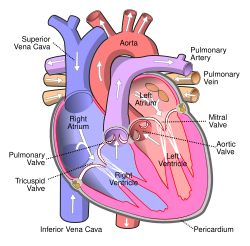Heart Failure Case Study

There are two types of heart failure.
Heart failure is one of the most fatal cardiovascular problems that killed almost millions of people across the globe. It is enlisted under the top ten causes of mortality in adults. This phenomenon involves the sudden malfunctioning of the heart (failure to pump blood), which reduces the amount of blood supply to other vital organs in the body.
The left-side heart failure affects the left atrium and left ventricle. The common manifestations of this type involve respiratory-related symptoms.Commonly, people suffering from left-side heart failure complain of difficulty of breathing.
The right-side heart failure is more systemic. It affects the major veins and arteries in the body. Most common signs and symptoms associated to this type are edematous, swelling, and distention of the veins.
What are the Possible Causes of Heart Failure?
Medically, there are other health problems that can contribute to the development of heart failure.
Most of these are related to vascular system. Atherosclerosis (hardening or narrowing of the vessels) is the most common cause of heart failure. If the vessels (canal for blood) are narrowed, it affects the normal circulation.This can lead to insufficient supply of blood, nutrients, and oxygen to other organs.
Other causes are fluid overload (usually, too much intake of intravenous fluids), high blood pressure, heart attack, blockage in the vessels caused by fat deposits, and pulmonary obstructive diseases such as asthma.
What are the Signs and Symptoms of Heart Failure?
The left-side heart failure involves clinical manifestations that particularly affecting the respiratory system. These include difficulty of breathing, presence of crackles when the lungs are auscultated, shortness of breathing when lying, bluish discoloration of the skin (caused by insufficient amount of oxygen in the tissues and skin layers), fast breathing when sleeping, rapid heartbeat (abnormal heart rhythm), anxious, and cough.
The right-side heart failure may manifests increase in weight, feeling nauseated, stomach fullness caused by anorexia, easily fatigued, rapid heartbeat (more than 100 beats per minute), and abdominal distention.
In cases that these signs and symptoms are present after having health histories of the identified causes of heart failure, consult your cardiologist for early diagnosis and treatment regimen.
Prevention is the best medicine for a failing heart.
What are the Treatment Modalities for Heart Failure?
Usually, the cardiologist will advise people suffering from heart failure with the following regimen:
- Observe for low-salt and low-fat diet. Avoid ingesting too much of oral fluids.
- People with extreme difficulty of breathing (below 12 respiratory cycles per minute) will undergo oxygen therapy. There is also a possibility of intubation and mechanical ventilation (for critical cases).
- Family members should regularly monitor the vital signs (especially the respiratory rate and cardiac rate) of the patient. This is to determine the current condition of the heart and lungs).
- They are advised to sleep at a semi-fowler’s position (upper body is elevated) to improve lung expansion and airway ventilation.
- Monitor for the intake and output of the patient on a daily basis. This is to prevent water overload. Every cup of water and food eaten is measured. The urine output, bowel movement, and other means of fluid elimination (except for immeasurable) is recorded.
- Measure the weight on a daily basis. This is to detect for fluid retention. If a person weighs 2 pounds or more in one day or 5 pounds or more in a week then he has fluid retention.
The most crucial part in treating heart failure is to implement the common preventive measures.These include diet restrictions, regular consultation to the doctor, religious compliance of medicines, and follows the recommended regimen for home-based care – By Edter

Comments
Post a Comment